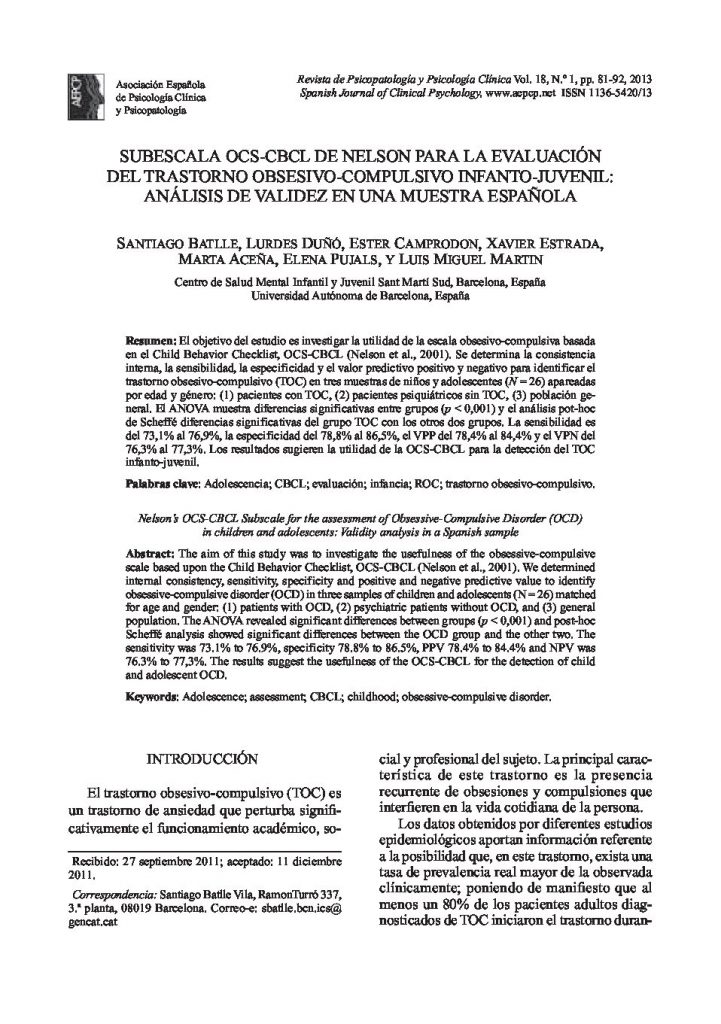Subescala OCS-CBCL de Nelson para la evaluación del trastorno obsesivo-compulsivo infanto-juvenil: Análisis de validez en una muestra española.
Subescala OCS-CBCL de Nelson para la evaluación del trastorno obsesivo-compulsivo infanto-juvenil: Análisis de validez en una muestra española.

- Construcción y validación preliminar de la Escala Multidimensional de Sensibilidad al Asco (EMA).
- Dimensiones de sensibilidad al asco y predicción diferencial de los síntomas fóbicos.
- Conformidad con roles femeninos y conductas alimentarias inadecuadas en estudiantes de danza.
- Estudio de la validez de la versión española del Cuestionario de Estilo Atribucional ante Situaciones Negativas.
- Valoración de la imagen corporal y de los comportamientos alimentarios en universitarios.
- La falta de empatía: ¿Un síntoma específico de la esquizofrenia?.
- Subescala OCS-CBCL de Nelson para la evaluación del trastorno obsesivo-compulsivo infanto-juvenil: Análisis de validez en una muestra española.
The aim of this study was to investigate the usefulness of the obsessive-compulsive scale based upon the Child Behavior Checklist, OCS-CBCL (Nelson et al., 2001). We determined internal consistency, sensitivity, specificity and positive and negative predictive value to identify obsessive-compulsive disorder (OCD) in three samples of children and adolescents (N = 26) matched for age and gender: (1) patients with OCD, (2) psychiatric patients without OCD and (3) general population. The ANOVA revealed significant differences between groups (p < 0,001) and post hoc Scheffé analysis showed significant differences between the OCD group and the other two. The sensitivity was 73.1% to 76.9%, specificity 78.8% to 86.5%, PPV78.4% to 84.4% and NPV was 76.3% to 77,3%. The results suggest the usefulness of the OCS-CBCL for the detection of child and adolescent OCD.
El objetivo del estudio es investigar la utilidad de la escala obsesivo-compulsiva basada en el Child Behavior Checklist, OCS-CBCL (Nelson et al., 2001). Se determina la consistencia interna, la sensibilidad, la especificidad y el valor predictivo positivo y negativo para identificar el trastorno obsesivo-compulsivo (TOC) en tres muestras de niños y adolescentes (N = 26) apareadas por edad y género: (1) pacientes con TOC, (2) pacientes psiquiátricos sin TOC, y (3) población general. El ANOVA muestra diferencias significativas entre grupos (p < 0,001) y el análisis post-hoc de Scheffé diferencias significativas del grupo TOC con los otros dos grupos. La sensibilidad es del 73,1% al 76,9%, la especificidad del 78,8% al 86,5%, el VPP del 78,4% al 84,4% y el VPN del 76,3% al 77,3%. Los resultados sugieren la utilidad de la OCS-CBCL para la detección del TOC infanto-juvenil.



